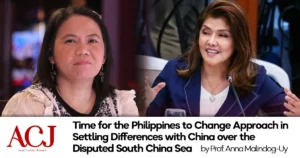IN a global landscape heavily influenced by Western capitalism and liberal democracy as the dominant paradigm, often imposed upon regions of the Global South as the sole route to economic and political progress and advancement, China’s approach and journey to modernization and economic development diverges significantly.
Instead of adhering strictly to the Western models, China has charted its own path, drawing on its rich historical context and legacy, unique internal dynamics and realities, and cultural heritage. This distinct trajectory challenges the notion that development must mimic Western models and standards, highlighting and showcasing the potential for alternative routes to economic progress and prosperity rooted in the local context, Indigenous experiences and values.
Opening up, reforms and transformation
After its opening in the 1970s, China’s rapid growth into the second-largest economy in the world, with growing global economic, diplomatic and political influence today, makes China not only one of the most influential countries in today’s international politics and economics but also an inspiration to the Global South.
In just more than four decades, China’s economic miracle, anchored on China’s reform and opening up, transitioning from a closed, centrally planned economy to a more market-oriented one, has led to remarkable economic growth, transforming China into the largest trading country in the world and a global economic powerhouse.
Globally, China is the second-largest and strongest economy in the Global South. It is one of the world’s largest sources of outbound investment in various sectors such as technology, agriculture, energy, infrastructure, etc. Its GDP (gross domestic product) growth in terms of “purchasing power parity” equivalence has been thus far the largest in the world for a few decades now, often outpacing the growth of developed countries.
This rapid growth has been fueled by a combination of factors, including large-scale industrialization, an increasing consumer base, a high investment ratio with a high savings rate and high FDI (foreign direct investment) inflow, structural upgrading, government spending and exports, factors of production such as labor, land and capital moving from low productivity sectors to high-performing and productive economic sectors that China has comparative and competitive advantages, the population bonus, particularly a high ratio of labor with high literacy and competitiveness due to massive investment in human capital.
It is also noteworthy to mention and emphasize the state’s role in China’s path to modernization and development. While the market is the mechanism behind incentivizing firms and the efficient allocation of resources such as land, labor and capital, one can see that, in China’s economic miracle, the state (i.e., national and local governments) is responsible.
It plays a critical role in institutionalizing the legal and social framework for maintaining fair and square market competition, providing public goods and services, redistributing income, addressing and correcting market externalities, and stabilizing the economy.
In addition, some key political and decisive factors like a strong state, the decisiveness and strong political will of the Chinese government and its leaders, the pursuit of good governance, China’s unified and cohesive coordination between the central government, provinces, cities and counties; and the cohesiveness of the Chinese society and unity in spirit and vision for China among and between the people and its government, are composite pivotal political factors that could explain the entirety of China’s economic miracle, of how and why it is where it is today — an economic powerhouse of the world.
Moreover, internal peace and political stability are significant factors in the economic development of any country, and China is no exception. The Chinese economic miracle, which refers to the rapid economic growth and industrialization that China has experienced since the late 1970s, can also be attributed to internal peace and political stability, among others.
Indeed, the essence of the widely acknowledged “Chinese economic miracle,” realized within a mere four decades, stems from the fusion of these crucial elements coupled with strategic foresight and meticulous long-term planning.
Triumph over poverty
It is also worth mentioning China’s remarkable triumphs over poverty, uplifting around 800 million people out of poverty since its economic reforms began in 1978. By the end of 2020, China had eradicate extreme poverty, with no individuals living below their national poverty line.
Such a feat is considered to be human history’s most extraordinary anti-poverty story that inspires countries in the Global South. This accounts for over 70 percent of global poverty reduction. China has met its poverty eradication target set out by the 2030 United Nations Agenda for Sustainable Development, 10 years ahead of schedule.
Nevertheless, poverty alleviation in China remains an ongoing concern, particularly in addressing relative poverty and ensuring that vulnerable populations do not fall back below the poverty line due to economic fluctuations or other crises.
Moreover, emerging as a pivotal force and an engine of global economic growth, China is a catalyst for worldwide economic advancement, surpassing major economies in its contribution to global GDP growth in recent years.
Despite the several challenges that the Chinese economy is facing, such as transitioning from an export and investment-led growth model to one driven more by consumption and services, addressing environmental concerns, dealing with an aging population, geopolitical tensions and differences with the US-led Western alliance, forecasts by international bodies like the International Monetary Fund consistently anticipate China’s continued economic growth trajectory, albeit at a moderated pace in recent years.
Alternative path
Reflecting on China’s phenomenal journey toward rapid economic development, a compelling narrative of growth and opportunity offers valuable insights for developing countries like the Philippines on their journey toward inclusive, sustainable and equitable economic development and progress.
First, the Chinese economic miracle illuminates an alternative pathway to economic advancement, development and modernization for the Global South. This stands in contrast to the Western-centric model characterized by the “dependence trap,” where the Global South relies on aid from a few affluent countries in the North, often former colonial powers, which comes with prescribed stringent structural conditions aimed at enforcing reforms exemplified by liberalization, privatization and deregulation, among others, leading to the perpetuation of existing inequalities, and reinforcing disparities in wealth, power and resources.
This entrenched system underscores the enduring divide between the North and South. China’s experience suggests that viable alternatives exist to this status quo, offering hope for a more inclusive and sustainable approach to economic expansion and progress.
Likewise, China’s trajectory toward development and modernization stands out as a unique narrative, distinct from any attempt to replicate Western models. Yet, its journey parallels many developing nations across Asia, Latin America and Africa, having endured and grappled with the harsh legacies of imperialism and colonization.
This shared experience of colonialism and imperialism binds China and the Global South together, fostering a sense of solidarity and camaraderie in their pursuit of development and modernization paths that resonate with their own unique spirits, conditions and historical realities. They find strength and solidarity in this shared and collective narrative, propelling them toward a future shaped by their distinct perspectives and aspirations.
Conclusion
In hindsight, China’s evolution toward development and modernization unveils a narrative uniquely crafted to its own context, rendering it unsuitable for replication elsewhere. However, its story serves as inspiration and guidance for other developing nations.
Countries in the Global South can extract valuable insights and learn best practices from China’s journey toward economic advancement. Furthermore, developing countries can find inspiration in China’s economic approach, which remains grounded in its historical experience.
By heeding the lessons of China’s economic transformation, these countries can navigate their own paths toward economic development and prosperity accessible to all members of society without compromising national independence, sovereignty, cultural identity, unique values and cherished traditions.
Source: The Manila Times
https://www.manilatimes.net/2024/02/24/opinion/columns/chinas-economic-miracle-a-source-of-inspiration-for-developing-nations/1933826



